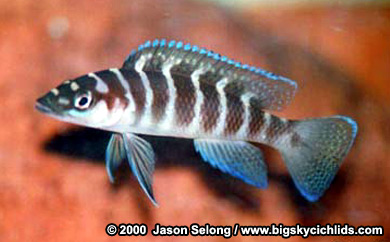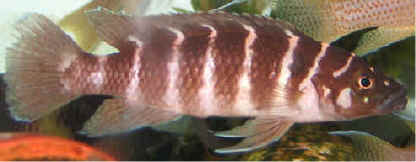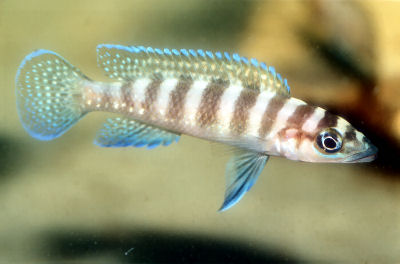Neolamprologus cylindricus
Origin: Lake Tanganjika, south eastern coast, from Karema to Isanga.
Etymology: cylindricus(L.): refers to the body shape of the fish.
Synonyms: Lamprologus cylindricus, Neolamprologus sp. "adriani"
Class: Actinopterygii (ray-finned fishes) Order: Perciformes Family: Cichlidae
First European import: Germany, 1983, by Afrika-Aquarium
Description:See picture(s)
Care: Neolamprologus cylindricus is best kept in pairs, since the fish are aggressiv towards their own kind. Buying 6 juveniles is recommended, as the fish are difficult to sex. After a pair has formed, the remaining fish should be removed. Provide the fish with lots of hiding places, created with stones and plants. A sandy soil is recommended. Water medium hard, neutral to alkaline, and biweekly waterchanges.
Temperature: 23-28 °C
Feeding: Omnivorous, live and frozen food is recommended, but flake food is also accepted.
Size: up to 12 cm.
pH: 7.0-8.5
Breeding: A well cared for pair will spawn in a community tank. The pair will spawn in a hole, which is carefully cleaned. The female will guard and care for the eggs, the male will guard the surrounding. Up to 200 small greenish eggs can be produced, that will hatch in 4 to 5 days, and are free swimming after two weeks.
Sexual dimorphism: Males are larger.
Prices: Around 5 €
Additional: Do not try to keep this fish together with other Neolamprologus



Distribution:
The Cylinder Cichlid was described by Staeck and Seegers in 1986. These fish are endemic to Lake Tanganyika, Africa. They are found in the south-eastern part of Lake at depths from 0 - 32 feet (10 m) inhabiting rocky bottomed areas. They search in the recesses of the substrate and in the bio cover for inverts to feed on. The parents are cave spawners and raise their fry in seclusion.
Status:
This species is not on the IUCN Red List for endangered species.
Description:
The Cylinder Cichlid is an elongated, cylindrically shaped fish. There are several vertical thick gray black to black bars with thinner white bars in-between. The face is gray-black to black with irregular shaped spots. They have a blue edging on the fins and at times their lips tend to be blue as well. Their teeth are very sharp due to the nature of their dietary needs. It is unknown how long this fish lives.
It is reported that the Cylinder Cichlids caught at the southern most end of the Lake have more yellow between the dark bars instead of all white. These are officially called the 'Gold head Cylindricus' variation as they sometimes have gold on the snout of the males as well.
All cichlids share a common feature that some saltwater fish such as wrasses and parrotfish have and that is a well-developed pharyngeal set of teeth that are in the throat, along with their regular teeth. Cichlids have spiny rays in the back parts of the anal, dorsal, pectoral, and pelvic fins to help discourage predators. The front part of these fins are soft and perfect for precise positions and effortless movements in the water as opposed to fast swimming.
Cichlids have one nostril on each side while other fish have 2 sets. To sense “smells” in the water, they suck water in and expel the water right back out after being “sampled” for a short or longer time, depending on how much the cichlid needs to “smell” the water. This feature is shared by saltwater damselfish and cichlids are thought to be closely related.
Size - Weight:
The Cylinder Cichlid grows to a length of 5” (12.5 cm).
Care and feeding:
The Cylinder Cichlid is basically carnivorous in the wild, eating small fish and crustaceans. In the aquarium they can be fed mysis shrimp, earthworm flake, frozen adult brine shrimp and once in a while spirulina. Other special food for carnivorous Lake Tanganyika cichlids are acceptable. It is suggested that you do not feed live foods and tubifex worms due to possible diseases and pathogens that may be transferred to your fish. Feed 2 to 5 small pinches of food a day in smaller amounts instead of a large quantity once a day. A one-day-a-week 'fast' can also be beneficial. All fish benefit from vitamins and supplements added to their foods.
A minimum 40 gallon tank for a single fish is suggested, and 55 gallons or more for a community type tank.They do fine in either freshwater or brackish freshwater but need good water movement along with very strong and efficient filtration. For freshwater an optional practice is to add 1 heaping teaspoon of salt per 11 gallons of water. This is considered to be a simple and natural remedy for wounds, minor fungal infections and film over the eyes of fish in transit. Using a marine salt (used for salt water fish) will add some trace elements
Many caves and a lot of rock work will make the Cylinder Cichlid comfortable. They are aggressive and need a lot of room. Plants may help the fry to survive and can be arranged in a very pleasing manner. For example; in the foreground try Cryptocoryne species, in the middle ground use Swordplants that are the larger variety, and the very back can have Water Fern. For a different or varied look you can plant on the porous rock with such species as Anubias, Water Fern and Java Fern.
Do normal water changes of only 10% to 15% a week, or more frequent changes depending on the nitrite/ammonia levels and stocking numbers. The Lake Tanganyika cichlids cannot handle large water changes very well unless the new water chemistry closely matches the water they are in. If a large water change is needed, changing 15% every couple of days should bring water back to normal. This inability to tolerate large water changes is due to Lake Tanganyika being very deep and the water tends to stay stable.
These fish are susceptible to typical fish ailments, especially if water is stale and of poor quality and oxygenation. An ounce of prevention is worth a pound of cure. Water changes, not overfeeding or overcrowding, and observation along with feeding your fish the proper foods (thawing frozen food and adding vitamins) will keep them in optimum health.
One common problem is Ich. It can be treated with the elevation of the tank temperature to 86° F (30° C) for 3 days. If that does not cure the Ich, then the fish needs to be treated with copper (remove any water conditioners). Several copper based fish medications are available for Ich. Copper use must be kept within the proper levels, so be sure to follow the manufacturers suggestions. You can also combine increasing the temperature with an Ich medication treatment. A copper test also can be used to keep the proper levels.
Water Region: Top, Middle, Bottom:
These fish will swim in the middle and bottom areas of the aquarium.
Acceptable Water Conditions:
Hardness: 10 - 13 dH
Ph: 8.6 to 9.5
Temp: 77 - 82° F (25 - 28° C)
Lake Tanganyika is the second to largest lake in the world, thus contributing to a low fluctuation in Ph and temperature. Several things all Lake Tanganyika cichlids need are:
Stable temperatures kept within acceptable limits.
Lots of oxygen to survive. Lake Tanganyika is a very oxygen rich lake. Bubblers need to be going day and night, even if there are plants.
Avoid overfeeding and overstocking.
Do a 10-15% water change weekly.
Regularly check nitrates (no more than 25 ppm), Ph (less than 7 is not tolerated), total hardness and carbonate hardness.
Social Behaviors:
The Cylinder Cichlid can be kept in pairs or singly. They are generally aggressive toward those of the same species, and with their sharp teeth, they can make quick elimination of conspecifics. They will tolerate those of a different genus as long as they are larger and colored differently.
This is an aggressive community fish, but may be kept with robust and larger Lake Tanganyika Cichlids that shoal, such as those of the genera Neolamprologus, Altolamprologus, and Cyprichromis . Do not keep with other fish that have similar body shapes and size, such as Julidochromis, or other fish that occupy territories similar to that of the Cylinder Cichlid. Males will kill any fish that is subdominant.
Sexual Differences:
No way to tell until adults, where the male may be a little larger.
Breeding/Reproduction:
The Cylinder Cichlid has been bred in captivity. They are cave spawners, and young couples need practice to become successful parents. Purchase 6 or more juveniles and allow them to pair up. After a pair has formed remove the remaining Cylinder Cichlids, because the newly established pair will attack the others.
They are easy to breed, but are best kept in their own breeding tank with another fish that takes the “punishment” of aggression from the parents. The reason is that part of the parent’s bond is associated with protecting the eggs and fry together. If there is not another fish in the tank for them to “protect” their young from, the male will generally turn on the female and damage her. Do not use plecostomos as they will eat the young during the night.
Provide the Cylinder Cichlid with caves that have smooth surfaces for their eggs to adhere. They can be made from rocks and/or clay planting pots and/or pieces of slate. Once the tank has been set up do not move any decorations around since this more than likely will break the bond a male and female have made.This is another part of their bond that is connected to the “territory” more than to each other. The male and female will hang around each other during spawning and drive the others away from their turf, which in turn strengthens their bond. If the tank is a community cichlid tank and you notice the fry not surviving due to other cichlids eating them all, on the next hatch carefully siphon the fry out of the tank. Don't chase or rearrange the tank, and do not take all of the fry or the parents become confused and will start to eat the next spawns.
The female deposits about 30 - 100 small olive colored eggs in the cave and the male will then fertilize them. The eggs hatch in about 4 - 10 days depending on the temperature of the water. The parents both share the duty of guarding the eggs and fry, keeping other fish away from their young. By 14 - 16 days, the fry are free-swimming and will remain protected by the parents until a new spawn comes along. Fry can be fed crushed dry foods, although hatched or frozen baby artemia, and/or artemia replacement foods are needed due to their high lipid and protein level. These foods contribute to improved survival rates and increased growth rates.
The Cylinder Cichlid is available both online and in fish stores, ranging from $5.00 - $17.00 USD for juveniles. Purchase from a reputable dealer, due to hybridization it takes a trained eye to choose the correct color strain that has not been crossed.
